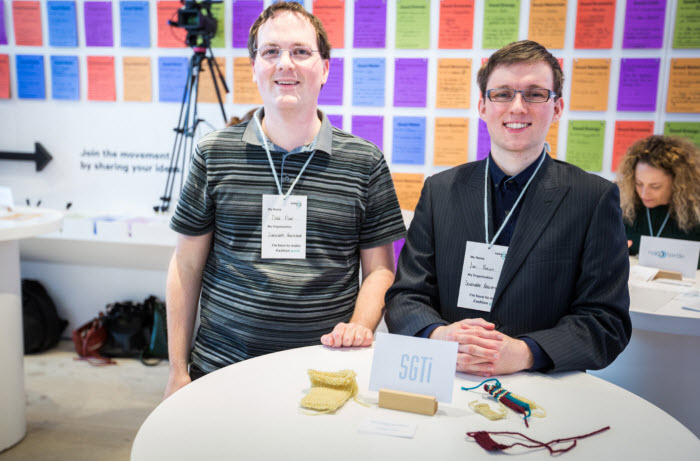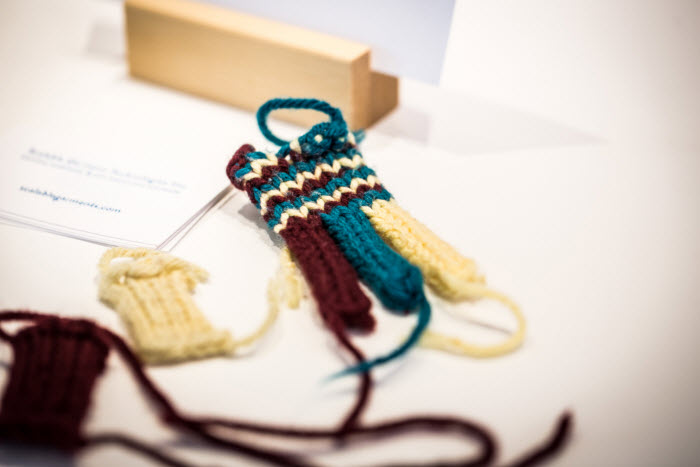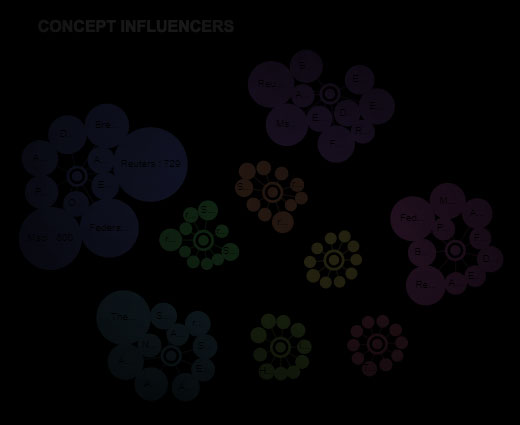The third edition of the Fashion for Good Plug and Play Accelerator, which took place back in March, turned the spotlight onto 15 innovative start-up businesses whose future-fit products look to bring a new dynamic to the textile industry. Technologies included biodegradable glitter, seaweed-based fabric and a sustainable alternative to binder chemicals for finishing. And, the start-up line-up also showcased innovation in the knitting sector in the form of a new robotic knitting machine and 3D modelling software concept.
 Dale Floer (left) and Ian Brown, co-founders of Scalable Garment Technologies Inc at the Fashion for Good event
Dale Floer (left) and Ian Brown, co-founders of Scalable Garment Technologies Inc at the Fashion for Good event
Designed by Vancouver-based Scalable Garment Technologies Inc. (SGTi) the solution looks to make custom seamless knit garments, rivalling technologies from established knitting machinery brands. The knitting technology enables digitalisation of the entire production process and on-demand manufacturing of custom seamless knit garments.
Speaking to WTiN, SGTi co-founders Dale Floer and Ian Brown explain where the project is currently at: “We are in the early stages of development right now,” says Floer. “We’ve been working on a prototype knitting machine and on some prototype software. [The machine] is a flatbed weft machine. The current version is limited but we’re working on a utility patent for it.”
The company’s vision is to provide the industry with a solution that enables seamless, customisable production and minimises waste. Floer and Brown come from software development and engineering backgrounds respectively and were initially astounded by the lack of automation in the CMT segment of the textile and apparel sector.
 A prototype knit made using SGTi’s solution
A prototype knit made using SGTi’s solution
Floer says: “We started on this [project] three years ago and it’s taken quite a while to figure out how things are currently done and how things could be done. We didn’t know a whole lot about how clothing is made. We approached the problem as: how would we make clothing given modern technology? Rather than, how should we automate current ways of making clothing.”
“It’s the engineering way,” adds Brown adds. “We had originally been looking at CNC cut and sew. But we were so surprised at how technologically behind apparel manufacturing is in general. Most of the [existing technology] is based on machinery that is 100s of years old, just with electric motors and computers added.”
Approaching the automation challenge from a new perspective, Brown and Floer began to look at a number of technologies that could impact the market including 3D printing, CNC milling and 3D design software. “We were questioning why this wasn’t being used in clothing,” says Floer. “Knitting is essentially [a process of] building layers up and that looks a lot like 3D printing.”
The resulting plan for the company’s development is three-fold. The first component is a ‘true 3D design software,’ which the duo says is aimed to bring apparel design software in line with software used throughout engineering. SGTi will be able to offer modern, 3D design software to allow designers to create garments in 3D, which will also allow garments to be designed in VR and AR.
The second component of the knitting platform will be a physical simulation software, whereby clothing will be digitally prototyped quickly, instead of using costly and slow sampling processes. Floer says: “The business model is different to the current models where instead of 100,000 orders of one item are placed. Here it’s 100,000 orders of individual items. There’s a lot of sampling that goes into this, but it seemed like something that could be solved by 3D simulation.”
The output of the knit simulation software will be turned into knitting instructions which will then be fed into a unique knitting machine. Floer explains: “We’ve looked at the existing [technology] and this is quite different. We’ve moved much of the intelligence and complexity out of the actual machine and into the software that’s running it. It’s a more modern take on it where software is doing more of the work.”
Inspired by 3D-printing and CNC milling, among other new technologies, SGTi claims that this machine will allow the on-demand production of a variety of seamless, single- and double-knit knitwear items without human intervention, quickly changing between different types of clothing.
“The 3D model would go into the software and then that would be sent to the machine. We would produce the piece of clothing and then send that to the customer or to the company that has requested it,” adds Floer. “We’re not planning on doing this as a B2C solution, we’re planning on doing it as a B2B solution. The retailer would take responsibility for the ecommerce platform.”
Brown and Floer are supported in this venture by textile industry adviser Matthew Danchuck, a specialist in emerging technology for fashion and textiles, and business adviser Matias Marquez, founder finance-technology company, Buyatab Online. However, the company is also looking for other industry partners, both at the fashion end of the industry and from the machinery manufacturers.
The SGTi solution is an estimated two and a half years away from being commercially viable. The next step for the business will be to demonstrate the technology making items such as socks, and Floer and Brom plan to then move on to create a single knit garment and then a double-knit garment. “We’re also working on miniaturisation [of the stitch] to a 22-needle gauge,” adds Brown.
Have your say. Tweet and follow us @WTiNcomment
RELATED ARTICLES
-
Washington state broadens PFAS restrictions
- Otis Robinson
- WTiN
-
2025 ITIC explores circular innovation
- Julian Turner
- WTiN
-
Archroma achieves Cradle to Cradle Certifications
- Archroma
- WTiN
-
News Release
Dishang Group claims leading industry award








